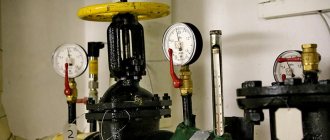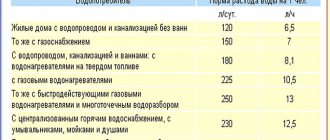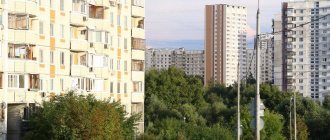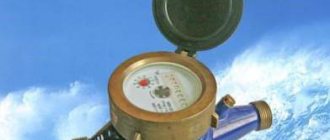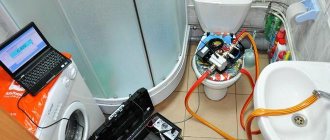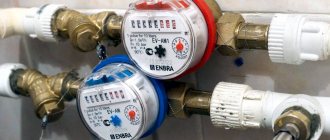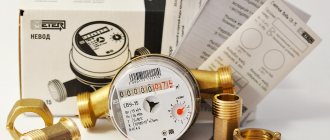Normal temperature of hot water in the apartment
The content of the article
In accordance with currently applicable regulations, apartments of citizens connected to a centralized hot water supply system must be supplied with hot water at a temperature of at least 60°C.
These standards establish maximum permissible deviations from this minimum. So, in the period from 0-00 to 5-00 the deviation can be 5°C, and in the remaining time, the maximum deviation can be 3°C.
Thus, taking into account the maximum permissible deviations, the temperature of hot water during the day cannot be lower than 57°C, and at night - 55°C.
What should the temperature of hot water in an apartment be according to law?
When paying for utilities, any user wants to get a quality product for their money. That is why you should not give up if lukewarm water flows out of the tap.
Important
Knowing the hot water temperature standards, you can try to influence the services that supply utilities: take measurements, draw up a report, make a recalculation, file a complaint with a higher authority. Statement of claim for the provision of utility services for hot water supply of inadequate quality and a reduction in fees for hot water.
You can learn how management companies make money by supplying hot water at insufficiently high temperatures from the video: Did you like the article? Follow site updates on VKontakte or Twitter.
Hot water temperature standards according to SanPin
SanPiN 2.1.4.2496-09, which were approved by the Decree of the Chief State Sanitary Doctor of the Russian Federation dated 04/07/2009 No. 20, set the minimum temperature of hot water supplied to apartments at 60°C. The same document also defines its maximum possible temperature, which is 75°C.
In addition, the above document also defines the maximum permissible deviations from these indicators. They are 5°C at night and 3°C during the day. It should be emphasized that these standards are designed to exclude the possibility of the proliferation of harmful microorganisms in hot water supply systems.
Experts, when calculating what temperature hot water should be, took this point into account. At the same time, hot water flowing from the tap should not cause thermal burns to the skin.
The powers to monitor the extent to which management and resource supply companies comply with these standards are assigned to the state housing inspection.
Separately, we emphasize that resource supply, and especially management companies, do not have the right to establish their own standards that differ from those contained in SanPiN 2.1.4.2496-09.
Rules for measuring hot water temperature. which document to believe?
Return to top Snake Zoyka eti18rus Activist Posts: 219 Registered: June 19, 2020, 08:21 Thanked: 19 times Thanked: 43 times act of measuring the temperature of hot water in the apartment
- Quote
In general, we draw up a handwritten report with a representative of the housing and communal services department, and write that we let water through at the water collection point for 3 minutes and take measurements, the temperature should be from 65 to 70 degrees, then we sign the report and take it to the resource officers)))) and so on that's all, and all this is in accordance with the law, by the way Back to top eti18rus Rembo Veteran Messages: 4011 Registered: 01 Jul 2020, 17:29 Thanked: 5993 times Thanked: 5031 times act of measuring the temperature of hot water in the apartment
- Quote
eti18rus wrote: The source of the quote is from 65 to 70 degrees, eti18rus wrote: The source of the quote and all this is in accordance with the law, by the way.
Permissible deviation of water temperature at the point of water intake
The maximum possible deviations from the established minimum and maximum hot water temperatures are established in the Decree of the Government of the Russian Federation of May 6, 2011 No. 354 “On the provision of utility services to owners and users of premises in apartment buildings and residential buildings”:
- during the period from 0-00 to 5-00, the maximum possible deviation is set within 5°C;
- during the period from 5-00 to 0-00, the maximum deviation is set within 3°C.
If the temperature of hot water goes beyond the above deviations, then for every 3°C, you have the right to demand a reduction in the cost of hot water by 0.1% for each hour of time during which the deviation lasts.
If the temperature of the water flowing from the hot tap is less than 40°C, then you have the right to pay for it at cold water supply rates. However, for this you should draw up and properly execute an act in which this deviation will be recorded.
Minimum indicator. As mentioned above, hot water should not be colder than 60°C. However, taking into account the maximum possible deviations, its temperature can be 57°C during the day and 55°C at night.
How to measure the water temperature in an aquarium. How to correctly measure the temperature in an aquarium
In my three aquariums there are such thin yellow thermometers. The temperature is constantly 27 degrees. Today I found the old thermometers so white, and where the mercury is red, and I decided to compare t. I’m shocked - the difference is 3 degrees lower and it turns out not 27, but 24 .What to do? Has anyone encountered such a problem and how can I check?
Monoceros:
Aren't electronic thermometers better? Can I get by with buying it right away?
Electronic ones are much WORSE. Especially household and aquarium cheap ones. More or less decent ones are much more expensive and again require constant supervision and calibration.
- And when you look at 27, read 24 and that’s it. By the way, the normal temperature is 24. It is better to raise it while the fish are being treated or to stimulate spawning. Raising fish from a young age at high temperatures will lead to intolerance to low temperatures if light and heat suddenly disappear in your apartment in winter. My friend once sat by an aquarium with a kettle for two days. I apologize, you live in Moscow, I didn’t look right away.
Go to the store and ask them to put five yellow alcohol thermometers on the counter. Wait 5 minutes and buy the one that shows the average temperature.
If the problem seriously concerns you, go to a laboratory equipment store, buy a new certified mercury thermometer, go with it to a store with aquarium thermometers and buy from the aquarium thermometer the one that will show the temperature closest to the laboratory mercury thermometer.
Hot water temperature value
You should monitor the temperature of the water flowing from the hot tap not only for economic reasons, but also for reasons of epidemiological safety.
This point is especially relevant for young children, elderly disabled people and other groups of citizens. In order not to jeopardize the life and health of citizens, the water temperature should not deviate from the established standards more than the maximum possible deviations, either downward or upward.
Having water temperature within established standards is not just a matter of comfort, but also of sanitary and epidemiological safety of citizens.
Sometimes, although this happens quite rarely, the water temperature can significantly exceed the established standards. This deviation creates a risk of thermal damage to the skin. To prevent this from happening, you should know what consequences exposure to hot water of a certain temperature can have on the skin:
- +50°C – when the skin is exposed to water at this temperature for more than 1.5 minutes, a minor thermal burn of the skin may occur;
- +55°C – when exposed to water at this temperature, a skin burn may occur within 15 seconds;
- +60°C – thermal damage to the skin will occur when exposed for 5 seconds;
- +65°C – severe thermal damage to the skin will occur with exposure lasting 2 seconds;
- +70°C – when the skin is exposed to water at this temperature, severe thermal damage occurs instantly.
Cases when water flows from a hot tap, the temperature of which is significantly lower than the standard temperature, are very common. This not only leads to an increase in its consumption and, as a consequence, financial costs for paying for poorly rendered services, but also makes it possible for the development of many negative situations.
For example, in a hot water supply system, in the event of a significant decrease in water temperature, the most favorable conditions are created for the life and development of various harmful microorganisms that can cause a number of diseases in humans.
Most often, in such conditions, the Legionella bacterium begins to develop. Warm fresh water is the most favorable environment for its life and reproduction. This pathogenic bacterium is a gram-negative rod, the size of which does not exceed 3 microns.
Underheating of the water entering the hot water supply system leads to the creation of the most favorable environment for Legionella in pipes and boilers.
As a result, they begin to develop rapidly and form huge colonies. This, in turn, poses a significant threat to human health.
The optimal habitat for these pathogenic bacteria is warm, fresh water. It is for this reason that they quite often infect low-temperature heating systems, where they create entire colonies.
Legionella can cause many diseases, the most severe of which is pneumonia with various complications.
This bacterium can enter your body during a bath or shower, while performing various hygiene procedures, as well as from dishes that were washed with contaminated water as a result of underheating.
When the water is heated to the temperatures established by current standards, then bacteria have no chance to survive and multiply, which means the likelihood of your infection is reduced to almost zero. For water to undergo complete thermal disinfection, it must be heated to at least 80°C.
Let's look at how water temperature affects the development and activity of Legionella:
- At a water temperature of less than 20°C, the bacterium loses its activity, it stops reproducing, enters suspended animation, but does not die;
- Water, the temperature of which ranges from 25 to 45°C, is the most favorable environment for the habitat, life and reproduction of this bacterium;
- If the water temperature remains at 55°C for 6 hours, these bacteria will die;
- If the water temperature is 60°C, then legionella colonies will be destroyed within 35 minutes;
- When the water temperature rises to 65°C, the bacteria die within 2 minutes;
- At a water temperature of 70 to 80°C, complete thermal disinfection of water occurs.
How to correctly measure the temperature of hot water in an apartment
Do not let the meter open the tap at full power so that the splashes fly all the way to the ceiling and you end up measuring not the temperature of the water in your tap, but the temperature of the water in the supply line at the entrance to the house, or in the boiler room. During one of the measurements, the meter and I grabbed the tap alternately - I decreased it, she added it. As a result, I wanted to record in the act the actual water consumption measured by the meter and the “measuring container,” but the commission snatched the act from my hands and took it away without my signature. But when at the trial the housing and communal services lawyer tried to attach this act to the case, in my opinion statement that “... AN ACT WITHOUT MY SIGNATURE IN ACCORDANCE WITH “RULES No. 354” CANNOT HAVE LEGAL FORCE..”, the judge refused this lawyer. Be prepared for the fact that the chief engineer will show his knowledge and will respond by “poking it under your nose” with the text “...Before taking hot water samples, you should drain the water until a constant temperature is established.
The water draining time can be up to 10 minutes, depending on the state of the distribution network and the hot water consumption mode of the consumer. When taking samples at the point where hot water is supplied to the distribution network, the water is not drained. The sample is taken into a container that meets the requirements of paragraph 3.2 of these Guidelines, with a continuous flow of water.
The water flow rate must be at least 2 liters per minute (determined by the time it takes to fill the measuring container). When taking a sample and carrying out measurements, excess water is poured over the edge of the sample container into a tray, and from it is removed into the sewer. 7.6. To measure the temperature of the sampled hot water, the thermometer is immersed in the water being tested so that the thermometer ball (or SI sensor) is approximately in the center of the sampling container.
Measurements are carried out with a continuous flow of water into the container.
Calculation coefficient for hot water in case of non-compliance with the standard
Having information about what temperature, according to current standards, hot water should be, you need to find out the coefficient that should apply to calculate the payment for it if the temperature of hot water deviates from the established standards.
If you find that the temperature of the water supplied to you as hot does not meet the approved standards, you have every right to demand a recalculation.
We emphasize that if the water flowing from a hot tap has a temperature below 40°C, then you must pay for it at the rates approved for cold water supply.
And if we talk about the coefficient used for calculation, it is 0.1% of the cost for every 3°C by which the water temperature was below the established standards. However, we should not forget about the maximum permissible deviations.
How to correctly measure the temperature of hot water in an apartment
You understand that the more water is drained before measurement, the greater the likelihood that it will not be the temperature of the water in the tap that will be measured, but the temperature of the water in the boiler room, which cools down on its way to your tap! Personally, I believe that the volume of water drained should be equal to the volume of the pipe from the hot water riser to the faucet. Usually it is 5-10 liters. But, unfortunately, there is no such rule in the documents. Practice in advance before the commission arrives what kind of stream should flow from the tap so that in 3 minutes a stream of 2 - 3 liters (no more!) fills the “measuring container”, i.e.
simply put - a saucepan, a basin with a volume of 3 minutes. x 2-3 liters = ≈ 6-10 liters! This is a very small stream. It is advisable to measure the water consumption using a meter; it should not exceed the above-mentioned 6-10 liters. When measuring, note the time yourself - you probably have a stopwatch in your mobile phone.
Measuring the temperature of hot water in the apartment
Unfortunately, if you decide to measure the temperature of the hot water that enters your apartment on your own, it will not have legal force.
However, this does not mean that it is not worth implementing. By measuring the temperature of the hot water yourself, you will be able to understand whether you should involve independent experts in this process, or whether everything is within the normal range.
In addition, based on the results of such measurements, you will have grounds to file a complaint with the management or resource supply company.
To measure the hot water temperature, do the following:
- open the tap from which hot water flows and wait a few minutes until it drains;
- after that, find a container with a volume of at least a liter, place it in the sink and turn the tap so that hot water flows into it. Water should completely fill the container and begin to flow out of it;
- Place a thermometer designed for measuring temperature in liquids into the container into which hot water flows;
- When the thermometer readings are recorded, remove it from the water.
Based on the results obtained as a result of these actions, you will be able to understand what the temperature of the water coming to you from the hot tap is and how much it deviates from the standards and decide what actions to take next.
It is worth remembering that temperature measurements must be taken as close as possible to the place where the water comes out of the tap, since when it comes into contact with the environment, the water cools quite quickly, and this can have a significant impact on the results of your measurements.
Having realized from the results of the measurements taken that you are being supplied with very sub-cooled water, you should submit a corresponding complaint, properly formatting it, to the management or resource supply company.
Eliminating the reasons why you receive hot water whose temperature is different from the established norm is their responsibility.
How to measure the temperature of tap water. How to measure temperature
Now a little about how to measure the temperature of hot water in a tap in residential buildings. It should be said that the results of measurements carried out by residents are not proof that management companies provided poor quality utility services. But in any case, after independent measurement, you can make sure whether the quality of the supplied water meets the conditions that suppliers are required to supply to the apartments of a multi-storey building according to current standards, and the temperature of hot water in the water collection points will also be determined. This is necessary to file a complaint with the relevant authorities when the hot water is not up to standard.
The sequence of independent measurements is as follows:
- You need to open the tap and let the water drain for about three minutes.
- Take any container of at least 1 liter and fill it with water that flows from the tap.
- Take a temperature meter and insert it into the hot liquid closer to the base.
- Wait until the mercury stops on the thermometer and remove it from the container.
From these measurement results it can be determined whether the detected value corresponds to the recommended values. You should know that the measurement is carried out only at the water tap point (where the water comes out of the mixer). No measurements should be taken at other points, since the degrees drop there, and this is the concern of resource supply and management companies.
As a result, there is no need to provide employees of the management organization with excuses to blame all these issues on the residents of the building, because sanitary standards for the temperature of hot water in apartments are enshrined in the laws, and the causal connections between the owners and tenants of apartments do not concern them. The main thing that residents need is to be aware of who to write an application for recalculation of payments for housing and communal services that were provided poorly.
IMPORTANT! Research that determines the standard temperature of hot water in an apartment should be entrusted to an accredited company that has license certificates authorizing such activities.
Where to go if hot water is not up to standard
If the hot water temperature does not meet the standards and you want to achieve a recalculation, then you should act in accordance with the Decree of the Government of the Russian Federation dated May 6, 2011 No. 354 “On the provision of utility services to owners and users of premises in apartment buildings and residential buildings.” It is in this document that the procedure for your actions is prescribed.
Let's take a quick look at how you should proceed:
- If you find that the hot water temperature deviates significantly from the norm, you should immediately notify the manager of the management or resource supply company. In this case, notification is possible both in written and oral form;
- The dispatcher whom you notified about this fact is obliged to record your request;
- In the appeal that you submit to the dispatcher, clearly state the essence of the problem that has arisen, indicate your last name, first name, patronymic and contact information, including address and telephone number;
- The dispatcher who accepted your request must introduce himself and state his position. After he registers your appeal, you should check with him under what number it was registered;
- If the dispatcher is aware of the causes of the problem you are experiencing, he should inform you about them, as well as the measures that are being taken to eliminate them;
- If nothing is known about the reasons that caused your problems, then an appropriate check will be carried out upon your request. If necessary, the time of its holding will be agreed with you;
- Based on the results of the inspection, an appropriate act must be drawn up. It will record whether violations were identified during the inspection, the reasons that led to them, the methodology by which the measurements were taken, as well as other information;
- The above act is drawn up in two copies, one of which is given to you as the applicant, and the second remains with the organization that carried out the inspection;
- If you are not satisfied with the results of the inspection, you have the right to insist on repeating it with the involvement of independent specialists.
If an inspection is carried out with the participation of an independent specialist, the time at which it will be carried out must be agreed upon with all interested parties.
This inspection will be carried out at the expense of the management or resource supply company, however, if its results confirm the results of the previous inspection, you will have to reimburse all costs for its implementation.
Actions after you receive the document in your hands
Having received a report in your hands, which records the fact that the hot water temperature does not comply with current standards, you can safely request a recalculation from the management or resource supply company.
In the event that, upon your contact to the dispatcher, and even more so based on the results of a repeat inspection, no actions are taken to eliminate the causes of the problem, you have every right to file a complaint with the Federal Service for Surveillance in the Sphere of Consumer Rights Protection and well-being of a person, or file a claim with a magistrate.
How to write a complaint about low hot water temperature
This complaint can be typed on a computer or written by hand.
The main thing is that it must contain the following data:
- In the upper left corner, provide information about yourself, including your full name, residential address and contact phone number;
- Below, indicate which organization you are contacting and, if possible, which of its officials;
- Once this above information is included in the header of the document, you should begin writing the main part of the complaint. In it, describe the essence of your problem in as much detail as possible. Tell her where and when you have already contacted her, and what kind of reaction there was to your request. It is advisable in this part to make references to regulations;
- When the main part of the complaint is written, you should list all the documents and materials that you consider necessary to attach to it;
- After this, the complaint is sealed with your handwritten signature and date.
Initially, such a complaint should be filed with the management or resource supply company. If you are refused to consider it or simply left without an answer, contact the Federal Service for Surveillance on Consumer Rights Protection and Human Welfare. You can also submit it to the Prosecutor's Office, or file a claim with the judicial authorities.
Recalculation of payment for water of inadequate quality
How to achieve recalculation if the temperature of the water from the hot tap does not meet the standards?
Having received a report that records the deviation of the hot water temperature from the established standards, contact the management or resource supply company and ask for a recalculation. At the same time, you must clearly define for what specific time period it should be carried out.
It is customary to take the date indicated in the act as the beginning of this period. The end date of the period is the date when, after eliminating the causes that led to your problem, final measurements were taken.
If you are denied a recalculation, file a complaint with the Federal Service for Supervision of Consumer Rights Protection and Human Welfare or file a claim with the judicial authorities.
In accordance with Article 7.23 of the Code of Administrative Offenses of the Russian Federation, persons whose guilt in non-compliance of hot water temperature with established standards is proven may be subject to administrative punishment.
Officials may be fined from 500 to 1,000 rubles, and for legal entities the fine may be from 5,000 to 10,000 rubles.
Everyone who pays for utilities wants them to be provided at the proper level. Therefore, you should not put up with a situation where the quality of utility services provided to you does not meet established standards.
Proposed changes in standards for the provision of hot water supply
Increasingly, resource supply companies are raising the question that the standard hot water temperature needs to be reduced to 60°C.
They also contact the Federal Service for Supervision of Consumer Rights Protection and Human Welfare with a proposal for such a reduction. They justify this proposal by the need to save energy.
To do this, they offer two options on how to achieve such savings:
- According to the first, it is proposed to replace thermal disinfection of water with disinfection using special means. Those promoting this option argue that disinfection using special means will be more effective and will ensure that end consumers are not infected;
- Proponents of the second option suggest reducing the temperature of hot water to 50°C, and for thermal disinfection, warming it up to 70°C once a day. Experts promoting this option try to refer to supposedly existing world experience, arguing that this method will not only allow for thermal disinfection, but also reduce the number of thermal injuries among consumers.
However, these two very dubious options have many opponents.
By way of objection, they argue:
- First of all, in resolving this issue it is necessary to find out the opinion of the consumers themselves. After all, the proposed changes will primarily affect their interests. The proposed measures can have a significant impact on comfort. But the fact that they will save money raises serious and very reasonable doubts. It is unlikely that energy supply companies, having started spending less on heating, will reduce tariffs for end consumers. Thus, they will increase their profits, and the situation of the end user may only worsen;
- In addition, an analysis of cases in the housing and communal services system clearly shows that if the minimum temperature of hot water is lowered, we risk receiving hot water at the inlet, the actual temperature of which will be 40-45°C;
- In addition, since resource supply companies have different financial capabilities in different regions of our homeland, we may be faced with a situation where many of them will not be able to purchase expensive products for chemical disinfection, and thermal disinfection will no longer be carried out. Thus, the end consumer will not be protected from possible infection.
Thus, it is thermal disinfection, in today’s realities of our country, that is the most effective method that guarantees that harmful microorganisms cannot develop in the hot water supply system and lead to infection of the end consumer.
Fortunately for us, the idea of changing the current regulations was not approved by the Government. But apparently, resource supply companies will not give up their attempts to achieve their introduction.
Housing and communal services in Russia, all hot water temperature standards
In chronological order of their publications. The headings of inactive (cancelled) regulations are crossed out. For an abbreviated list, see the end of the file.
INTERNAL WATER PIPELINE AND SEWERAGE OF BUILDINGS SNiP 2.04.01-85*
see the current Code of Practice SP 30.13330.2012
... 2.2. The temperature of hot water at water intake points should be provided:
- a) not lower than 60 °C - for centralized hot water supply systems connected to open heat supply systems;
- b) not lower than 50 °C - for centralized hot water supply systems connected to “closed heat supply systems;
- c) not higher than 75 °C - for all systems specified in subparagraphs “a” and “b”.
Set of rules SP 30.13330.2012
"INTERNAL WATER PIPELINE AND SEWERAGE OF BUILDINGS"
Updated version of SNiP 2.04.01-85*
- “...5.1.2. The temperature of hot water at water collection points must comply with the requirements of SanPiN 2.1.4.1074 and SanPiN 2.1.4.2496-09 and, regardless of the heat supply system used, must be no lower than 60 °C and no higher than 75 °C.”
SanPiN 4723-88 “SANITARY RULES FOR THE CONSTRUCTION AND OPERATION OF CENTRALIZED HOT WATER SUPPLY SYSTEMS”
see current SanPiN 2.1.4.2496-09
(approved by the Chief State Sanitary Doctor of the USSR in November 1988)
- “...1.7. The temperature of hot water in water supply points, regardless of the heat supply system used, must be no lower than 60°C and no higher than 75°C.
Note. For a hot water supply system made of galvanized pipes with a closed heating system, it is allowed to have a water temperature of no lower than 50°C and no higher than 60°C. Under these conditions, after carrying out repair work or eliminating emergency situations in the systems, it is necessary to maintain the temperature at 75°C for 48 hours.”
GOST R 51617-2000.
HOUSING AND COMMUNAL SERVICES. GENERAL TECHNICAL CONDITIONS
- “... 4.16.3 The temperature of hot water at consumers’ water collection points should be from 50 to 75 °C [20. SanPiN No. 4723-88 Sanitary rules for the design and operation of centralized hot water supply systems ]
HYGIENIC REQUIREMENTS FOR ENSURING THE SAFETY OF HOT WATER SUPPLY SYSTEMS
"1. Application area
- 1.1. Sanitary and epidemiological rules and regulations establish hygienic requirements for water quality and the organization of centralized hot water supply systems (hereinafter referred to as DHW), as well as rules for monitoring the quality of water supplied to DHW, regardless of departmental affiliation and forms of ownership.
- 1.2. These sanitary rules are mandatory for all legal entities and individual entrepreneurs whose activities are related to the organization and (or) provision of centralized hot water supply systems...
2. General provisions
- …2.3. Sanitary and epidemiological requirements for centralized hot water supply systems are aimed at:
- - prevention of contamination of hot water with highly contagious infectious pathogens of viral and bacterial origin that can reproduce at temperatures below 60 degrees, including Legionella Pneumophila;...
- 2.4. The temperature of hot water in water collection areas, regardless of the heat supply system used, must be no lower than 60 C and no higher than 75 C.
3. Requirements for the design, construction, operation of centralized hot water supply systems
3.1.10. When operating the DHW, the water temperature at the water intake points should not be lower than + 60 ° C, the static pressure is not less than 0.05 mPa, with pipelines and water heaters filled with tap water….
“RULES AND STANDARDS FOR TECHNICAL OPERATION OF HOUSING STOCK”
(approved by the Post of the State Construction Committee of the Russian Federation dated September 27, 2003 No. 170)
“... 5.3. Hot water supply
- 5.3.1. ... The temperature of water supplied to water points (taps, mixers) must be at least 60 degrees. C in open hot water supply systems and at least 50 degrees. C - in closed. The water temperature in the hot water supply system must be maintained using an automatic regulator, the installation of which in the hot water supply system is mandatory. The water temperature at the outlet of the water heater of the hot water supply system must be selected from the condition of ensuring the normalized temperature at the water supply points, but not more than 75 degrees. WITH."
RULES FOR PROVIDING PUBLIC SERVICES TO CITIZENS
(Approved by Decree of the Government of the Russian Federation of May 23, 2006 No. 307)
see current Post. No. 354
…P. 5 Ensuring the temperature of hot water at the point of analysis:
- not less than 60°C – for open centralized heating systems;
- not less than 50°C – for closed district heating systems;
- no more than 75°C - for any heat supply systems"
RULES FOR THE PROVISION OF PUBLIC SERVICES
TO OWNERS AND USERS OF PREMISES IN MULTIPLE-Apartment BUILDINGS AND RESIDENTIAL BUILDINGS
(Approved by Decree of the Government of the Russian Federation of May 6, 2011 N 354)
REQUIREMENTS
to the quality of public services
5. ...Ensuring compliance of the hot water temperature at the point of water collection with the requirements of the legislation of the Russian Federation on technical regulation (SanPiN 2.1.4.2496-09)
PS There is an interesting document: “DECISION OF THE SUPREME COURT OF THE RF OF MAY 31, 2013 N AKPI13-394”, which, among other things, establishes:
“SanPiN 2.1.4.2496-09, as follows from the content of its paragraphs 1.1 and 1.2, establishes hygienic requirements for water quality and the organization of centralized hot water supply systems (hereinafter referred to as DHW), as well as rules for monitoring the quality of water supplied to DHW, regardless of departmental affiliation and forms of ownership, and is mandatory for execution by all legal entities and individual entrepreneurs whose activities are related to the organization and (or) provision of centralized hot water supply systems.
According to the specified SanPiN, the temperature of hot water in places of water supply, regardless of the heat supply system used, must be no lower than 60 °C and no higher than 75 °C. These sanitary and epidemiological requirements for centralized hot water supply systems are aimed, among other things, at preventing contamination of hot water by highly contagious infectious pathogens of viral and bacterial origin that can multiply at temperatures below 60 degrees, including Legionella Pneumophila, as well as at preventing skin diseases and subcutaneous tissue, due to the quality of hot water (clauses 2.3 and 2.4).
Thus, the sanitary and epidemiological rules define the requirements for the quality of hot water supplied to consumers when providing public hot water supply services according to an indicator that ensures its safety, such as temperature. This indicator is characterized by a minimum (not lower than 60 °C) and a maximum limit (not higher than 75 °C) and does not allow deviations from the specified temperature regime , subject to which the quality of the utility service is ensured.”
The temperature of hot water in water collection areas, regardless of the heat supply system used, must be no lower than 60 C and no higher than 75 C.
BASES:
clause 5.1.2 SP 30.13330.2012 “ Internal water supply and sewerage of buildings ”
Updated version of SNiP 2.04.01-85*;
clause 2.4 SANPiN 2.1.4.2496-09 “Hygienic requirements for ensuring the safety of hot water supply systems”;
5.3.1 “ Rules and standards for the technical operation of the housing stock” (approved by the Post of the State Construction Committee of the Russian Federation dated September 27, 2003 No. 170);
Clause 5 of Appendix 1 “ Rules for the provision of utility services to owners and users of premises in apartment buildings and residential buildings” (approved by the Russian Federation Government Resolution dated May 6, 2011 No. 354).
Compiled by housing and communal services specialist Yuri Kalnin
Standard and permissible deviation of hot water temperature in the apartment
Attention
Sampling of water from a consumer's tap Sampling of water is carried out at the outlet of the taps of the internal water supply networks of houses. When sampling from a consumer's tap, the time to drain the water before sampling depends on the purpose of sampling.
If the purpose of sampling is to assess the effect of materials in contact with water on water quality, then samples should be collected without first draining the water.
For other purposes, 2-3 minutes of draining the water is sufficient to establish equilibrium conditions before sampling. 3. METHODOLOGICAL INSTRUCTIONS MUK 4.3.2900-11. Date of introduction: July 12, 2011 (G.G. ONISCHENKO). 4.3. CONTROL METHODS. PHYSICAL FACTORS MEASUREMENT OF HOT WATER TEMPERATURE IN DISTRICT HOT WATER SUPPLY SYSTEMS 5. Before taking hot water samples, drain the water until a constant temperature is established.
About standards for air temperatures and hot water in apartments
In accordance with clause 5 of the “Rules for the provision of utility services to owners and users of premises in apartment buildings and residential buildings”, approved by Decree of the Government of the Russian Federation of May 6, 2011 No. 354, the beginning of the heating period should be set at an average daily outdoor temperature below 8 degrees Celsius. Celsius, and the end of the heating period - when the average daily outside air temperature is above 8 degrees Celsius for 5 days in a row. The specified period must begin or end on the day following the last day of such period.
The heating season, in accordance with the Government Decree, begins by decision of local authorities. In Ryazan, the heating season started at the end of September, but many residents complain that it is cold in the apartment. The most pressing questions for Ryazan residents remain questions about standards for air temperature in the apartment and hot water temperature. These indicators will be discussed in this article.
Sample report from residents about the lack of hot water in the apartment | Roman law
The right of citizens of the Russian Federation to receive hot water is established by an agreement with utility companies on the provision of services, sanitary and hygienic standards, regulations on the provision of utility services, etc. When faced with gross violations, it is necessary to quickly take action and hold workers in the sector accountable for the lack of water.
In this case, the specified act is signed by at least 2 consumers and the chairman of the board of an apartment building in which a partnership or cooperative has not been created, the chairman of the partnership or cooperative if the management of the apartment building is carried out by a partnership or cooperative.
The inspection report indicates the date and time of the inspection, identified violations of the quality parameters of the utility service, the methods (tools) used during the inspection to identify such violations, conclusions about the date and time of the beginning of the violation of the quality of the utility service.
The housing and communal services sector has always been associated with a large number of problems. Residents of apartment buildings often complain about the provision of services by public utilities.
Claims can be sent on any issues related to the activities of the Management Company, for example, a requirement to recalculate housing and communal services or replace a leaking roof.
Standard hot water temperature
We drew up an act to turn off the heating and hot water in our house during the period of October 7-8. Representatives of the Green Island Management Company refused not only to sign, but even to accept the act as an incoming document. Let me remind you that the boiler room also went offline on October 11 and 12, but it was quickly restarted.
The behavior of the employees of the management company "Green Island" in this situation indicates a desire to cover up the problem, although what happened is an emergency, shutting down the boiler room for the same period at low temperatures will very likely lead to serious damage to both the boiler room and heating system circuit, not to mention the fact that the temperature in the apartments will drop below acceptable levels.
After scheduled work or eliminating the consequences of an accident, hot but rusty water may flow from the tap. As a rule, when contacting the control room, the applicant will be informed of the reason and assured that quality will be restored within a few hours.
They should be placed at the bottom of the page being compiled, and also placed in square brackets indicating the source number corresponding to its position in the list of references.
How to record the fact of provision of utility services of inadequate quality?
It is best to draw up a sample complaint collectively. Public appeals will be considered on a priority basis.
To file a claim, it is necessary to create an initiative group, which must consist of three or more people living in the house where the water was cut off.
It is the representatives of the initiative group who will organize the process and speak on behalf of all residents.
Even a planned or emergency shutdown of hot water causes a lot of inconvenience, let alone those situations when only cold water suddenly starts flowing from both taps. At the same time, no notifications were received from the organization servicing the house, and the date for resumption of hot water supply is unknown. There is only one way out - to appeal the actions of the management company and restore your rights.
During the daytime, deviations are not allowed. For each hour of deviation in air temperature in a residential area in total during the billing period, the fee is reduced by 0.15% of the fee determined for such billing period, for each degree of temperature deviation.
Such a document needs to be created only in the presence of a commission, which should include representatives from the local government, other residents and a mechanic from the housing office.
Do not let the meter open the tap at full power so that the splashes fly all the way to the ceiling and you end up measuring not the temperature of the water in your tap, but the temperature of the water in the supply line at the entrance to the house, or in the boiler room.
During one of the measurements, the meter and I grabbed the tap alternately - I decreased it, she increased it. As a result, I wanted to write down in the act the actual water consumption measured by the meter and the “measuring container,” but the commission snatched the act from my hands and took it away without my signature.
But when at the trial the housing and communal services lawyer tried to attach this act to the case, according to my statement that “... an act without my signature in accordance with “Rules No. 354” cannot have legal force..”, the judge refused this lawyer.
If representatives ignore the written request, you can conduct an inspection with other residents, and make a note in the report about the invitations sent.
At the same time, when filling out the power outage form, it is mandatory to include the following information (in accordance with clause 12 of the rules for the full and (or) partial regime of limiting electricity consumption, approved.
The standards for hot water temperature within 60-75 degrees were not invented by chance, but correspond to sanitary safety rules. Such water will serve as an additional source of disinfection, preventing the proliferation of pathogenic microflora.
However, it is difficult to check this parameter by eye.
File a complaint about insufficient hot water temperature to the management company. At the end of the complaint article in PDF format, enter your details and print.
The application must be written in two copies. One of them is transferred to the management company. It is imperative to check that the application is registered in the incoming correspondence log. The second copy, which remains with the applicants, must be affixed with an incoming stamp. In the future, this may be required to prepare a statement of claim in court.
Quite often, citizens of the Russian Federation think that a complaint against public utilities is a waste of time. It is important to remember that with a competent and reasoned approach to business, you can always achieve results. Turning off hot water is no exception. If you are not confident in your abilities and legal knowledge, it is best to seek help from an experienced professional.
A lawyer knows all the “sharp corners” of the law and will help you get around them and avoid common mistakes in the fight against utility structures for hot water. Mr. Kozlov A.P.
as the reason for the lack of asphalt, he refers to the bankruptcy of Comfortable City LLC, and the letter of guarantee indicates the time of laying the asphalt - the 2nd quarter of 2014, but, as is known, there was no bankruptcy procedure during the specified period.
Indoor air temperature after the start of the heating season
In accordance with the State Standard of the Russian Federation GOST R 51617-2000 “Housing and communal services. General technical conditions”, adopted by the Decree of the State Standard of the Russian Federation dated June 19, 2000 No. 158-st (Table 3), the minimum temperature is set: corner room - 20 ° C; living room – 18°C; kitchen – 18°C; bathroom – 25°C; toilet – 18°С, combined bathroom – 25°С; bathroom with individual heating – 18°C; common washroom – 18°C; shared shower – 25°C; public restroom – 16°C; lobby, common corridor, hallway in an apartment building, staircase – 16°C; lobby, common corridor, staircase in the dormitory - 18°C; elevator room – 5°C.
To find out the air temperature in the room after the start of the heating season, you need to measure it in a certain way: place a thermometer on the inner wall of each room at a distance of 1 meter from the outer wall and 1.5 meters from the floor and measure it for 10 minutes.
In accordance with Appendix No. 1 to the “Rules for the provision of utility services to owners and users of premises in apartment buildings and residential buildings”, approved by Decree of the Government of the Russian Federation of May 6, 2011 No. 354 (hereinafter referred to as the Rules), heating must be uninterrupted and around the clock during the entire heating season. The permissible duration of a heating break is no more than 24 hours (in total) for one month; no more than 16 hours at a time - at an air temperature in residential premises from 12 to 22 degrees. No more than 8 hours at a time at a room temperature of 10 to 12 degrees, no more than 4 hours at a room temperature of 8 to 10 degrees. For every hour exceeding the specified standards, the monthly heating fee is reduced by 0.15%.

